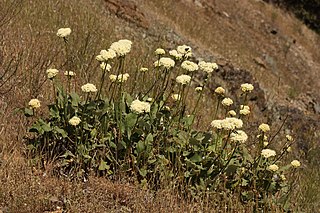
Eriogonum is a genus of flowering plants in the family Polygonaceae. The genus is found in North America and is known as wild buckwheat. This is a highly species-rich genus, and indications are that active speciation is continuing. It includes some common wildflowers such as the California buckwheat.

Eriogonum nudum is a perennial shrub of the wild buckwheat genus which is known by the common name naked buckwheat or nude buckwheat.

Eriogonum fasciculatum is a species of wild buckwheat known by the common names California buckwheat and flat-topped buckwheat. Characterized by small, white and pink flower clusters that give off a cottony effect, this species grows variably from a patchy mat to a wide shrub, with the flowers turning a rusty color after blooming. This plant is of great benefit across its various habitats, providing an important food resource for a diversity of insect and mammal species. It also provides numerous ecosystem services for humans, including erosion control, post-fire mitigation, increases in crop yields when planted in hedgerows, and high habitat restoration value.
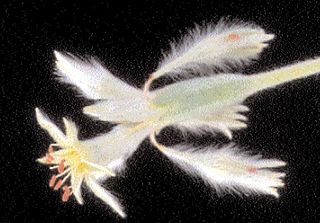
Eriogonum longifolium Nutt. var. gnaphalifolium Gand., commonly referred to as scrub buckwheat is a dicot of the Polygonaceae family. It is listed as threatened in the US and endangered in Florida. Within Florida its most closely related species is Eriogonum tomentosum however there are three other varieties of Eriogonum longifolium found in other areas of the US.
Eriogonum dasyanthemum is a species of wild buckwheat known by the common name chaparral buckwheat. This plant is endemic to California where it is limited to the Northern Coast Ranges, but it is quite common in its native range.
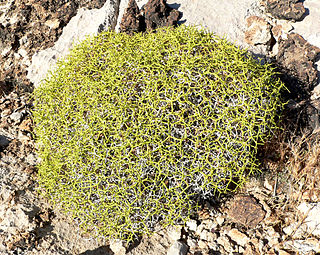
Eriogonum heermannii is a species of wild buckwheat known by the common name Heermann's buckwheat. It is native to the southwestern United States from California to Utah where it grows on rocky slopes, desert flats, and dry washes.
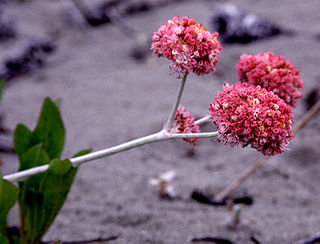
Eriogonum latifolium is a species of wild buckwheat known by the common names seaside buckwheat and coast buckwheat. This plant is native to the coastline of the western United States from Washington to central California, where it is a common resident of coastal bluffs and scrub.

Eriogonum nidularium is a species of wild buckwheat known by the common name birdnest buckwheat. It is native to the sandy flats and desert dry washes of the Mojave Desert and Great Basin in the western United States, where it is common and abundant. This is a distinctive annual herb producing a thin, multibranched stem which curves in on itself to form a rounded, tangled mass.

Eriogonum wrightii is a species of wild buckwheat known by the common names bastardsage and Wright's buckwheat. It is native to the Southwestern United States, California, and northwest Mexico, where it grows in many plant communities, such as chaparral, in rocky habitats from mountains to deserts.
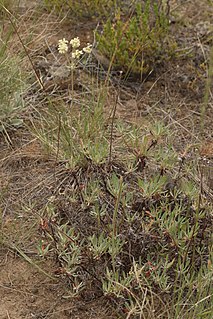
Eriogonum heracleoides is a plant of western North America that has many flowering clusters which are usually cream colored, or off-white. It can usually be found in rocky areas, such as sagebrush deserts and Ponderosa pine forests. Parsnipflower buckwheat is in the genus Eriogonum and the family Polygonaceae, which is a family of plants known as the "knotweed family". It inhabits much of the western part of the United States and southern British Columbia.

Eriogonum angulosum is a species of wild buckwheat known by the common name anglestem buckwheat.

Eriogonum contiguum is an uncommon species of wild buckwheat. It is commonly known as Reveal's buckwheat and annual desert trumpet. It is native to Death Valley in California and adjacent sections of Nevada. It is commonly found in Death Valley National Park and Mojave National Preserve. Eriogonum contiguum grows in sandy to gravelly flats and slopes, or rocky hills, and lower bajadas with Atriplex species. It is an annual herb which produces an erect, spreading stem up to about 30 centimeters high. Leaves are basal, small rounded, and woolly. The many scattered inflorescences are small, compact clusters of tiny hairy yellow flowers. Flowers bloom April to June. It is threatened due to habitat degradation by off road vehicles, competition with exotic plant species, trampling, grazing, and erosion.

Eriogonum gracile is a species of wild buckwheat known by the common name slender woolly buckwheat.
Eriogonum molestum is a species of wild buckwheat known by the common name pineland buckwheat. It is endemic to southern California, where it grows in the Transverse Ranges of Ventura County to the Peninsular Ranges of San Diego County.

Eriogonum palmerianum is a species of wild buckwheat known by the common name Palmer's buckwheat. It is native to the Southwestern region of the United States and Great Basin region, where it grows in many types of desert and sagebrush plateau habitat.
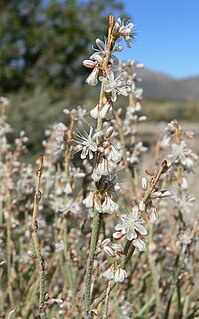
Eriogonum panamintense is a species of wild buckwheat known by the common name Panamint Mountain buckwheat. It is native to several of the desert mountain ranges of eastern California and western Nevada, including the Panamint Range. It grows in various types of mountain ridge habitat, such as sagebrush and coniferous woodland.

Eriogonum spergulinum is a species of wild buckwheat known by the common name spurry buckwheat.

Lepidium barnebyanum is a rare species of flowering plant in the family Brassicaceae known by the common names Barneby's pepperweed, Barneby's pepper-grass, and Barneby's ridge-cress. It is endemic to Utah, where there is a single population in Duchesne County. It is a federally listed endangered species of the United States.

Eriogonum niveum is a species of flowering plant in the buckwheat family known by the common name snow buckwheat. It is native to the Pacific Northwest of North America, where it occurs in British Columbia, Washington, Oregon, and Idaho. It flowers late in the summer.

Eriogonum thymoides is an "abundant" species of flowering plant in the buckwheat family known by the common name thymeleaf wild buckwheat, or simply thymeleaf buckwheat.

















